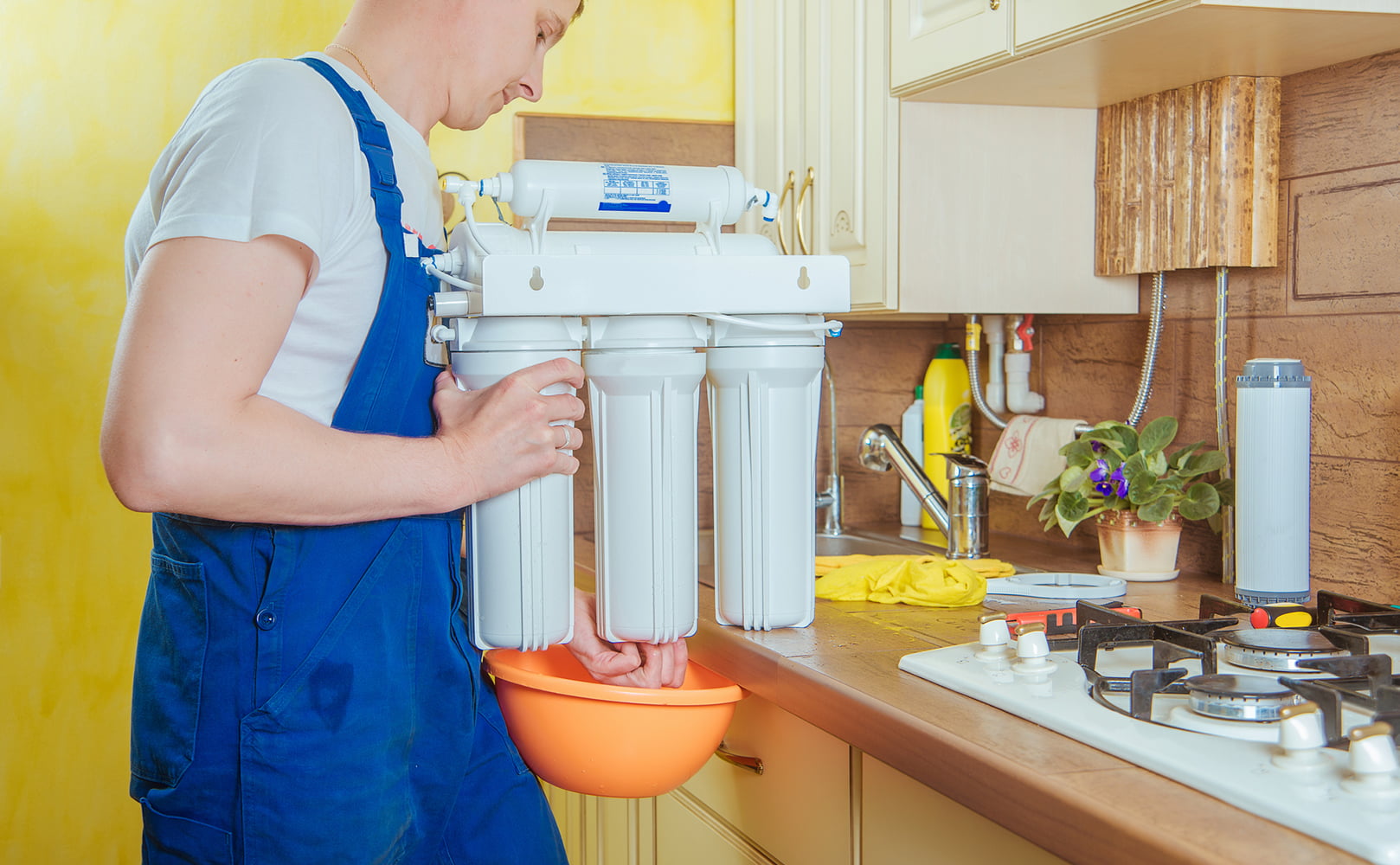How To Clean Water Purifier Storage Tank
Written by: Cistron Fitzgerald // Concluding Updated:
Please note: This page may contain affiliate links. If you buy a product or service through such a link we earn a committee at no additional cost to you. Larn more near our product review process or cheque our FTC affiliate disclosure.
Occasionally cleaning or rather sanitizing a reverse osmosis system guarantees optimum operation. Information technology rules out scaling and fouling for the highest h2o quality and flow. Plus, you lot are protected from potentially harmful pathogens.
How to sanitize an RO system properly? Don't worry, you can easily do this yourself without calling for a professional person. Find everything yous need to know in our guide beneath.
Contents
- How to sanitize a contrary osmosis organization
- Cleaning the RO membrane
- How to make clean a reverse osmosis tank
How to Sanitize a Reverse Osmosis Organization
Offset of all, cleaning and especially sanitizing a reverse osmosis arrangement is non necessary per se. If your feed water is already in decent condition y'all might get away without information technology.
However, we recommend you lot follow through with it as the process is pretty straightforward and doesn't crave much of your fourth dimension. And this fashion y'all are on the condom side, not only protected from potentially harmful microorganisms and the like, only likewise knowing that scaling and fouling won't touch output h2o flow and overall quality.
How often to clean/sanitize? Ideally one time a year, maybe twice if need be. What's nearly important is that y'all do this regularly to forestall irreversible damage. In our stance, the perfect time for cleaning is when you change i or more than of the filter elements (including the RO membrane).
In this case, here is how the process goes:
For specific instructions delight consult the transmission. As well, note that the post-filter will demand replacement subsequently this, unless you bypass it.
- Start by washing your hands.
- Prepare a bucket of warm dishwater. You lot should also have a scouring pad or brush at the ready. In addition, you will require about a quarter cup (3 tablespoons) of unscented household bleach, hydrogen peroxide or chlorine for disinfection – any NSF canonical sanitizer should work, as well.
- Turn off the water supply to the unit of measurement. Y'all don't want to inundation your kitchen.
- Disconnect any ice makers, refrigerators, etc.
- Open up the filtered water dispenser to depressurize the arrangement. Wait until the flow stops.
- Remove ALL pre-filters likewise as the RO membrane from their housings.
- Scrub the within of the housings with the dishwater. Rinse thoroughly subsequently.
- Add together the bleach into the housing of filter stage one.
- Double-cheque that the black rubber O-rings are in place and screw all empty housings back on.
- There should be no filters except for the post-filter installed at this point. If and then, turn on the water supply.
- Open the RO faucet until water comes out. Then close it.
- Check for leaks.
- Let the storage tank fill and let the bleach to stay in the arrangement for between 30 minutes and up to a couple of hours.
- Flush the entire system.
- Let the tank refill a 2nd time and flush out. All sanitizer olfactory property should accept vanished by now. If not, echo the flushing cycle.
- Turn off the water supply again.
- Depressurize the organisation by opening the faucet.
- Now you lot can install whatever new filter elements and those former ones that are nonetheless in good shape. Again, make sure that the condom O-rings sight tight to preclude any leaks. Remember to as well replace the polishing filter.
- Plough the water supply dorsum on.
- Open the RO faucet and let the organization flush for a couple of minutes.
- Check for leaks.
- Close the faucet to allow the tank fill.
- You should discard 1 or two full tanks of water before employ, although this might not be necessary depending on your organisation (refer to manufacturer instructions).
- Finally, you can reconnect your water ice maker or refrigerator.

The whole sanitizing thing didn't quite turn out every bit y'all had hoped? Perhaps information technology's time for a new organization. Check out our top 10 RO systems if you like.
Cleaning the RO Membrane
While you wait for the bleach to do its thing you could free the semipermeable reverse osmosis membrane from dirt (unless yous are planning to supervene upon information technology anyway).
In lodge to clean an RO membrane you lot need to soak it in dissimilar chemical solutions – remember to follow instructions regarding safe treatment and disposal – depending on its type and equally recommended by the manufacturer.
This will aid you to go rid of organic matter, calcium precipitates, mold, mildew and other nasty stuff which, in plow, prevents scaling and fouling.
Stride-By-Step Cleaning Instructions
For detailed step-by-step instructions bank check out our article on RO membrane cleaning (link to be added soon). Basically, you demand to:
- First, put on gloves and protective heart vesture.
- Prepare the cleaning solutions in non-reactive plastic buckets.
- Shut the water supply + tank valve and depressurize the arrangement.
- Take the RO membrane out of its housing.
- Soak the membrane in each of the chemical solutions for the recommended time. Rinse thoroughly after each bath.
- Put the system dorsum together.
- Flush the entire system for 20 to xxx minutes before using the water.
How to Make clean a Opposite Osmosis Tank
If you follow the procedure above which explains how to sanitize an entire RO system and so at that place is no need for you to make clean the storage tank separately as this has already been taken care of.
However, y'all might have noticed a foreign sense of taste in your water or a funny smell and you assume the tank to be the culprit. And then cleaning the storage tank lonely can make sense. Hither's how:
The post-filter volition need replacement afterward this, unless you featherbed it.
- Shut off the feed water supply.
- Open up the RO faucet to depressurize the system. Look until the flow stops.
- Close the tank valve and disconnect the tank tube from the rest of the system (leave the tube attached to the tank).
- Drain any water that'due south still inside the tube.
- Use a funnel or eyedropper to add unscented household bleach into the tube. Half a tablespoon should be more than enough. Hydrogen peroxide, chlorine or whatever NSF approved sanitizers are fine, too.
- Reconnect the tubing without the sanitizer leaking out.
- Open the tank valve and make certain that the RO dispenser is closed.
- Turn on the feed h2o supply.
- Check for leaks.
- Let the tank fill. The bleach volition kill whatever pathogens inside. Allow the bleach solution to sit down for thirty minutes upward to a couple of hours.
- Lastly, open the RO faucet to drain the tank. Let information technology refill and drain once again. All sanitizer scent should have vanished by now. If not, repeat the flushing cycle.
For more maintenance tips, check our RO h2o filter organisation maintenance guide.

If you have any questions about how to clean or sanitize a reverse osmosis system please don't hesitate to leave a annotate below!
Source: https://www.best-osmosis-systems.com/ro-clean-sanitize/
Posted by: jamersonstrapead.blogspot.com



0 Response to "How To Clean Water Purifier Storage Tank"
Post a Comment